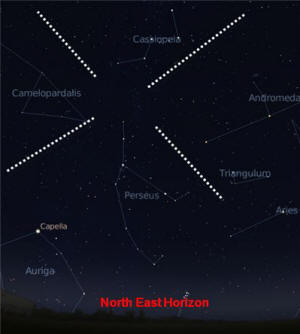|
Last
night, Melanie and I made our yearly trek to a reasonably dark place
to watch the Perseid meteor showers. The sky was moonless with the only
significant light pollution coming from the city of Erie in the east.
We camped at a marina, so there were a few parking lot lights in the
distance, but not in the direction of the meteors. It was nothing special.
We set up our camping chairs (very comfortable) at around 11:30
PM and stared at the sky until a little after 1:00 AM. Unlike last year
when we saw a couple really impressive fireballs, nothing remarkable
appeared this year. I counted about 15 total. With one exception, all
the meteors were bonafide Perseids since their trails originated in
the predicted direction of Perseus (see map below). If the radiant
point were to be any farther away from Perseus, they would be called
the Cassopeian Meteors. At our 42.1° latitude, at this time of year
Perseus is only about 20° up from the horizon around midnight.
 As
usual, even if the meteor shower experience is disappointing, the opportunity
to get reacquainted with the starry sky is utterly welcome. My house
is surrounded by tall tress, so the observing is lousy from the yard.
Nearby trains shake the ground and planes from the airport constantly
fly through the space, so nobody would ever consider establishing a
serious observatory here; astrophotography is out of the question. It
is amazing how far the train horns travel all the way to the lake shore
- a mile away and 100 feet below the track elevation (they blow those
*@^%# horns all night long). But I digress. As
usual, even if the meteor shower experience is disappointing, the opportunity
to get reacquainted with the starry sky is utterly welcome. My house
is surrounded by tall tress, so the observing is lousy from the yard.
Nearby trains shake the ground and planes from the airport constantly
fly through the space, so nobody would ever consider establishing a
serious observatory here; astrophotography is out of the question. It
is amazing how far the train horns travel all the way to the lake shore
- a mile away and 100 feet below the track elevation (they blow those
*@^%# horns all night long). But I digress. Because the sky was
unobstructed by cloud or haze cover, and because the moon had not yet
risen, an excellent view of the Milky Way was provided. A tree line
prevented seeing the more southerly constellations and stars, but everything
to the north was there in full splendor. Although I religiously read
Sky & Telescope magazine every month and review the sky charts in
a desperate attempt to prevent all aspects of my once heavily pursed
hobby from being lost, it takes actually getting out and observing to
refresh the image on my mind. I rely heavily on the oft-used
little sayings to help me find my way around the night sky, like "Follow
the arc to Arcturus," and then, "Speed on to Spica." The former refers
to continuing the arc of the handle of the Big Dipper (an asterism,
not a constellation) on down in to the constellation of Boötes , where
the bright red star Arcturus resides (3rd brightest star in the northern
sky). Then the latter instructs to keep going in the same arc until
you find the bright star Spica in the constellation of Sagittarius (bluish-white,
15th brightest in the northern sky). Cygnus the swan's bright star Deneb
(meaning tail) easily identifies the constellation that is said to be
"Flying down the Milky Way" because it stretches directly along the
thickest part of our galaxy's milky white background haze of stars. The Summer Triangle, composed of Cygnus' Deneb, the bright star
Vega in Lyra the lyre, and Altair in Aquila the eagle, was a sight to
behold against the backdrop of the Milky Way. Once Pegasus and Andromeda
had climbed out of the city light, the binoculars easily fond the Andromeda
Galaxy - always an awesome sight. It all brings back memories
of when I would climb through the access hatch to the roof of barracks
at Robins AFB, in Georgia, when my interest in astronomy was first kindled,
and use my star maps to learn the night sky. Unlike up north, from Georgia
I could see a few of the southern constellations. I really wanted to
catch a glimpse of the Magellanic Clouds (Large or Small), but they
were just too close to the southern celestial equator to see. I'll have
to settle for pictures since I doubt at this point in life I will ever
find myself below the Equator. So, overall it was a good night.
Next year I vow to take a pizza with me and spend more time.
|









